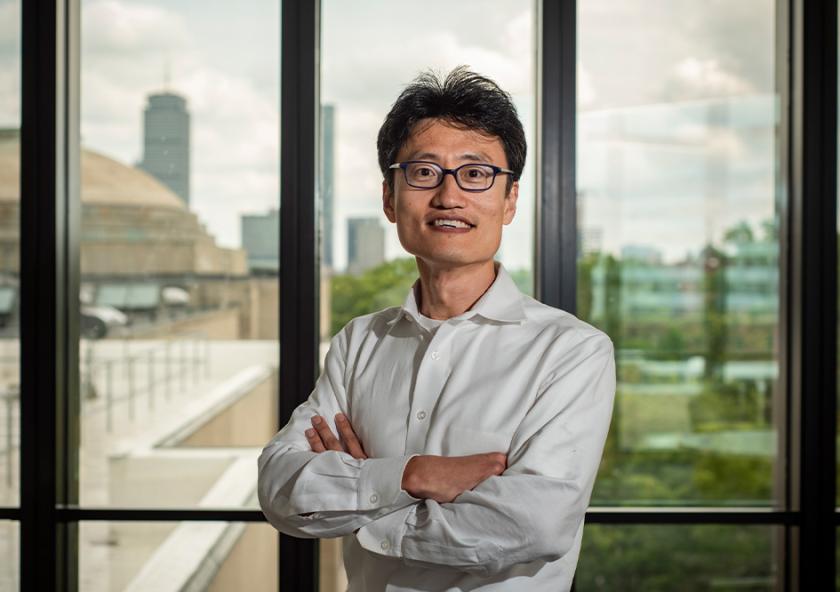
Taking the congestion out of commuting

Whether it’s been by foot, horse or car, the question has been eternal: What's the best way to get from Point A to Point B? At one time, the challenge was merely traffic, and the need was just moving in the fastest, cheapest, and safest way possible. Now it’s also about reducing carbon emissions and accommodating electric vehicles.
This is the nature of Jinhua Zhao’s work. “I study how people move and why people move,” says MIT's Edward and Joyce Linde Associate Professor of City and Transportation Planning. Ultimately, it’s about how to change how they move — not an easy task, because it involves motivation, but through the use of technology, and the potential that alternative forms of transportation continue to show, Zhao believes that there’s untapped potential to create more efficient and equitable systems.
The need for viable options
One of the Zhao’s main focuses is multi-modal mobility, in which he looks to use technology with various forms of transportation like buses, trains, scooters, shared vehicles, and bikes, all to improve commuting. The upside is that while needs vary from place to place, certain goals are similar across the globe. People want affordability, safety, and especially reliability, as in, “I want my bus to show up regularly,” he says. The challenge, he adds, is that “No single mode can satisfy all desires.” Public transit can decrease congestion and emissions, but it can’t be personalized. Cars provide the most freedom and flexibility, but they’re low capacity.
And location does matter. Denser cities have an advantage; places are closer together and having more people means more options can coexist. It also helps when a place is developed with the necessary roads, sidewalks, and technology. And what furthers any effort is when governments take the lead and coordinate their efforts, which isn’t always the case, Zhao says.
In most instances, Europe provides a model for the rest of the world for the above-mentioned reasons. In London, for example, the buses, trains, and roads are under the control of one agency, making it easier to pivot when there’s an inevitable stoppage, such as providing shuttles or repurposing buses when demand shifts. City officials also encourage walking and cycling. Overall, people have viable choices to consider, so the default decision isn’t to just hop into their car, Zhao says.
He’s looking at how to take that model and mindset and bring it to the United States. The fundamental challenge is how to change behavior, and usually that’s done in one of three ways: implementing charges, making rules, or establishing new norms. The first two are fairly straightforward — governments can charge tolls or close off streets to traffic. The third is trickier because it requires people to change a habit, which can take a long time, but once that personal buy-in happens, “It’s the more powerful one,” he says.
The stumbling block, especially in the United States, is overcoming what Zhao calls “car pride,” the qualitative value people put into their vehicle. It shows personality and status, and allows showing off by saying, “I can afford this.” It also equals independence. A person can go where they want, when they want to, and that’s hard to give up, particularly when there aren’t compelling alternatives.
One possible solution is to show car pride in another way, but that involves changing the accounting that’s done with driving. People can answer how much time a trip takes, or how much gas it costs. But ask them, “What’s your carbon output?” and they’ll shrug. Knowing doesn’t immediately solve the problem, but awareness is the first part of making the environment a priority, he says.
The other approach, which works in concert, is having better information. As Zhao says, a government needs to know its current operation, from how trains are running to where the buses are at any given moment. When there’s any kind of disruption, it’s then informing commuters of alternatives, so people aren’t deciding blindly and creating “chaos in the system.” London does just that with updating boards with sometimes the option of getting people to another station. The shortcoming is that a board can only provide so much and can’t personalize suggestions.
This is why Zhao says that any effort might work better as a public-private partnership, because no one owns the solution. “It needs a collective effect,” he says. The government agency can provide the infrastructure and a private company can provide an app. The latter can take into account a person’s set preferences, like number of stops or price; get their direct feedback; even predict; and deliver customized recommendations for that day.
Since it would be based on personal information, security is always a concern, but Zhao says that it’s also an opportunity. A company could offer a tiered service, with privacy being a selling point off the more expensive choices, but ultimately allowing the user to decide what they’re comfortable sharing. “It could be a differentiator,” he says.
And those electric cars
They’re viable, and they’ll become more so in the next 10 years, Zhao says, since people love them and they’ll always get resources. But they’re still limited. They work best when commutes are predictable, and if they’re going to become more widespread, improved battery strength, availability of charging stations, and more price points have to be worked out.
Infrastructure is the component that’s particularly key and one that gets “insufficient attention.” One thing that would help over the next decade is to demonstrate impact. Technology is becoming mature enough to show that congestion improves, and accidents decrease, and with that proof, investments should increase.
But money is a looming issue. In the United States, the government uses a gas tax to fund transportation, but as electric car usage increases, the tax base will shrink. It’s something “we hope will happen,” Zhao says, but it means a new financing formula needs to be developed. It’s one of the unanswered questions, but, like with many areas when it comes to the transportation, also one the great potentials.
“It makes the current discussion really interesting,” he says.

